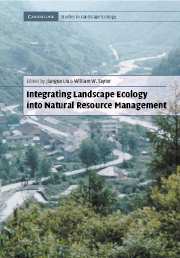Book contents
- Frontmatter
- Contents
- List of contributors
- Foreword
- Preface
- Acknowledgments
- PART I Introduction and concepts
- PART II Landscape structure and multi-scale management
- PART III Landscape function and cross-boundary management
- PART IV Landscape change and adaptive management
- 10 A landscape-transition matrix approach for land management
- 11 Tactical monitoring of landscapes
- 12 Landscape change: Patterns, effects, and implications for adaptive management of wildlife resources
- 13 Landscape ecology in highly managed regions: The benefits of collaboration between management and researchers
- PART V Landscape integrity and integrated management
- PART VI Syntheses and perspectives
- Index
- Plate Section
12 - Landscape change: Patterns, effects, and implications for adaptive management of wildlife resources
Published online by Cambridge University Press: 14 January 2010
- Frontmatter
- Contents
- List of contributors
- Foreword
- Preface
- Acknowledgments
- PART I Introduction and concepts
- PART II Landscape structure and multi-scale management
- PART III Landscape function and cross-boundary management
- PART IV Landscape change and adaptive management
- 10 A landscape-transition matrix approach for land management
- 11 Tactical monitoring of landscapes
- 12 Landscape change: Patterns, effects, and implications for adaptive management of wildlife resources
- 13 Landscape ecology in highly managed regions: The benefits of collaboration between management and researchers
- PART V Landscape integrity and integrated management
- PART VI Syntheses and perspectives
- Index
- Plate Section
Summary
Introduction
Landscape change is one of the foremost themes underlying landscape ecology research. This theme ranges from a focus on the causes of landscape change to the effect of landscape change on ecosystems and organisms. The end result of such diverse research has been the creation of a large body of knowledge and significant advance in the scientific understanding of landscapes. However, while knowledge has advanced, scientists and resource managers have only begun to integrate the findings into natural resource management. One strategy in natural resource management that offers a strong potential for integration with landscape change is adaptive management.
Adaptive management differs from traditional resource management (Halbert, 1993) by treating management actions as experiments with testable hypotheses (Holling, 1978; Walters, 1986; Lee, 1993; Gunderson, 1999). The intent of adaptive management is to maximize the information gained and thereby reduce uncertainty about the system, especially for those areas suspected to be critical to proper system function. Moreover, adaptive management emphasizes applying new knowledge to help refine and possibly alter future actions (Holling, 1978; Walters, 1986; Lee, 1993; Gunderson, 1999). This approach can be applied to landscapes by dividing the landscapes into experimental units that meet management goals while providing information about how landscape change affects management actions.
The objectives of this chapter are two-fold: (1) to describe various patterns and causes of landscape change, and summarize its effects on wildlife; and (2) to discuss using landscape change information in adaptive management of wildlife resources. To highlight these objectives in a real world situation we will present a case study of two watersheds in Michigan's Lower Peninsula that have contrasting landscape structures and patterns of landscape change.
- Type
- Chapter
- Information
- Integrating Landscape Ecology into Natural Resource Management , pp. 312 - 333Publisher: Cambridge University PressPrint publication year: 2002
- 6
- Cited by



